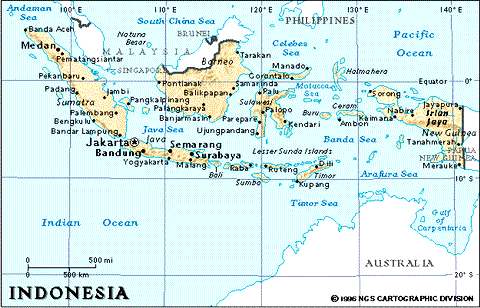
Indonesia Factbook


Geography
Location: Southeastern Asia, archipelago between the Indian Ocean and the
Pacific Ocean
Map references: Southeast Asia
Area:
total area: 1,919,440 sq km
land area: 1,826,440 sq km
comparative area: slightly less than three times the size of Texas
Land boundaries: total 2,602 km, Malaysia 1,782 km, Papua New Guinea 820 km
Coastline: 54,716 km
Maritime claims: measured from claimed archipelagic baselines
exclusive economic zone: 200 nm
territorial sea: 12 nm
International disputes: sovereignty over Timor Timur (East Timor Province)
disputed with Portugal and not recognised by the UN; two islands in dispute with Malaysia
Climate: tropical; hot, humid; more moderate in highlands
Terrain: mostly coastal lowlands; larger islands have interior mountains
Natural resources: petroleum, tin, natural gas, nickel, timber, bauxite, copper,
fertile soils, coal, gold, silver
Land use:
arable land: 8%
permanent crops: 3%
meadows and pastures: 7%
forest and woodland: 67%
other: 15%
Irrigated land: 75,500 sq km (1989 est.)
Environment:
current issues: deforestation; water pollution from industrial wastes, sewage; air
pollution in urban areas
natural hazards: occasional floods, severe droughts, and tsunamis
international agreements: party to - Biodiversity, Climate Change, Endangered
Species, Hazardous Wastes, Law of the Sea, Nuclear Test Ban, Ozone Layer Protection, Ship
Pollution, Tropical Timber 83, Wetlands; signed, but not ratified - Desertification,
Marine Life Conservation, Tropical Timber 94
Note: archipelago of 13,500 islands (6,000 inhabited); straddles Equator;
strategic location astride or along major sea lanes from Indian Ocean to Pacific Ocean

People
Population: 203,583,886 (July 1995 est.)
Age structure:
0-14 years: 32% (female 32,548,039; male 33,485,810)
15-64 years: 64% (female 65,394,816; male 64,914,362)
65 years and over: 4% (female 4,027,367; male 3,213,492) (July 1995 est.)
Population growth rate: 1.56% (1995 est.)
Birth rate: 24.06 births/1,000 population (1995 est.)
Death rate: 8.48 deaths/1,000 population (1995 est.)
Net migration rate: 0 migrant(s)/1,000 population (1995 est.)
Infant mortality rate: 65 deaths/1,000 live births (1995 est.)
Life expectancy at birth:
total population: 61.22 years
male: 59.13 years
female: 63.42 years (1995 est.)
Total fertility rate: 2.74 children born/woman (1995 est.)
Nationality:
noun: Indonesian(s)
adjective: Indonesian
Ethnic divisions: Javanese 45%, Sundanese 14%, Madurese 7.5%, coastal Malays
7.5%, other 26%
Religions: Muslim 87%, Protestant 6%, Roman Catholic 3%, Hindu 2%, Buddhist 1%,
other 1% (1985)
Languages: Bahasa Indonesia (modified form of Malay; official), English, Dutch,
local dialects the most widely spoken of which is Javanese
Literacy: age 15 and over can read and write (1990)
total population: 82%
male: 88%
female: 75%

From: The World
Factbook 1995


